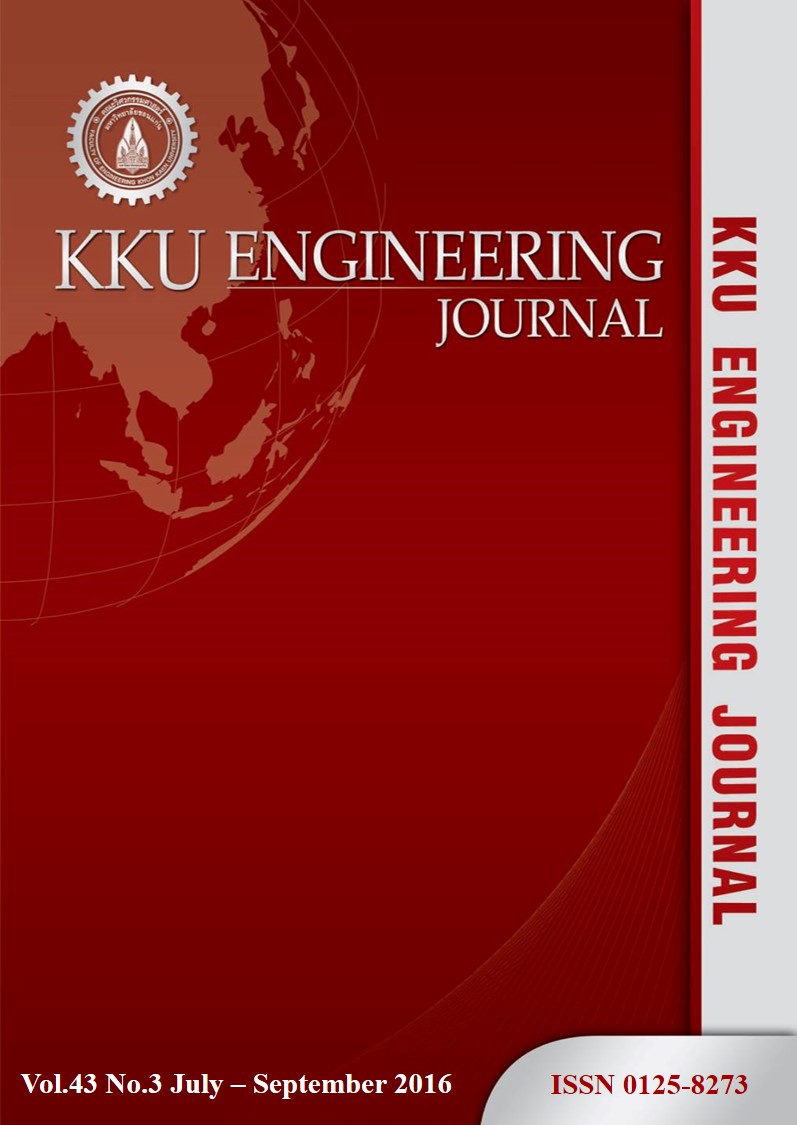Early detection of Parkinson’s diseases by using the relationship between time response and movement characteristics of human arms
Main Article Content
Abstract
Parkinson’s and stroke diseases are brain problems of many elderly people. This study was done to investigate an early detection method for Parkinson’s disease using the relationship between the brain time response and arm movement characteristics. 120 healthy people were examined and classified into four age groups (<20, 20-40, 41-60, >60 years old). The relationship between the two parameters was examined using a fabricated electronic device with an accelerometer on a hammer and a star-pattern generator a with a 9-position lighted keypad. Several simple and complex light patterns were designed to test brain function. The experimental treatments were developed using a 4×2 factorial experiment in a completely randomized design (CRD). The results showed that the time response of the >60 age group was the longest compared to other groups (p<0.01). Based on the experiments using a pattern-position approach, all age groups completed the simple pattern faster than the complex pattern (p<0.01). The accelerometer signal patterns in 20-40 years old and +60 years old were found to have polynomial and linear signal patterns, respectively. The relationship between the time response and the accelerometer signal were found to be negatively monotonic ( 0.835, p < 0.01). Therefore, this finding could identify healthy people without Parkinson’s disease with an accuracy of 99.58 %. The results suggest that tests such as these can be developed for early detection of Parkinson’s and related diseases.
Article Details
This work is licensed under a Creative Commons Attribution-NonCommercial-NoDerivatives 4.0 International License.
References
Munoz D, Broughton J, Goldring J, Armstrong I. Age-related performance of human subjects on saccadic eye movement tasks. Exp Brain Res. 1998;121(4):391-400.
Ali-Akbar S, Zahra M. Human brain performance in learning complex temporal patterns. International Conference of the IEEE Engineering in Medicine and Biology Society, 2009; 2009 Sep 3-6; Minneapolis, USA. USA: IEEE; 2009. p. 3967-70.
Jobbagy A, Furnee E, Harcos P, Tarczy M. Early detection of Parkinson's disease through automatic movement evaluation. IEEE Eng Med Biol Mag. 1998;17(2):81-8.
Fujita T, Onishi T, Kanda K, Maenaka K, Higuchi K. Evaluation of the human vibration for autonomous power source. World Automation Congress (WAC 2012); 2012 Jun 24-28; Puerto Vallarta, Mexico. USA: IEEE; 2012. p. 1-4.
Atif A, Rosa I, Eid M, Shervin S, Edward L. Haptic exercises for measuring improvement of post-stroke rehabilitation patients. 2007 IEEE International Workshop on Medical Measurement and Applications; 2007 May 4-5; Warsaw, Poland. USA: IEEE; 2007. p. 1-6.
Morello R, De Capua C, Meduri A. A wireless measurement system for estimation of human exposure to vibration during the use of handheld percussion machines. IEEE Trans Instrum Meas. 2010;59(10): 2513-21.
Frederik P, Frank B, Steven G, Fabien M, Marc E, Bert G, et al. Wireless vibration monitoring on human machine operator. 2010 17th IEEE Symposium on Communications and Vehicular Technology in the Benelux (SCVT2010); 2010 Nov 24-25; Enschede, Netherlands. USA: IEEE; 2010. p. 1-6.
Yanxi R, qingxia L. Implementation of human vibration test and evaluation system based on virtual instrument. 2010 International Conference on Mechanic Automation and Control Engineering (MACE); 2010 Jun 26-28; Wuhan, China. USA: IEEE; 2010. p. 1-6.
Bernstein ER, Peterson DR. Next generation device for recording daylong hand-arm vibration and grip force waveforms. 2007 IEEE 33rd Annual Northeast Bioengineering Conference; 2007 Mar 10-11; Long Island, USA. USA: IEEE; 2007. p. 100-1.
Liau B, Yeh S, Chiu C. Using cross-correlation function to assess dynamic cerebral auto regulation in response to posture changes for stroke patients. 2010 Computing in Cardiology; 2010 Sep 26-29; Belfast, Northern Ireland. USA: IEEE; 2010. p. 605-8.
Mohammed F A, Atif A, Abdulmotaleb E. Measuring hand-arm steadiness for post-stroke and parkinson's disease patients using SIERRA framework. 2010 IEEE International Workshop on Medical Measurements and Applications Proceedings (MeMeA); 2010 Apr 30-May 1; Ottawa, Canada. USA: IEEE; 2010. p. 1-4.
Michael AL, Stephen LS, Jane EA, Stuart EL, Katherine LP, Stuart J, et al. Evolving classifiers to recognize the movement characteristics of Parkinson's disease patients. IEEE Trans Evol Comput. 2014;18(4):559-76.
Zhi-Fei Z, Zhong-Ming X, Yansong H. Design of measurement and evaluation system for human exposure to mechanical vibration. 9th International Conference on Electronic Measurement & Instruments (ICEMI 2009); 2009 Aug 16-19; Beijing, China. USA: IEEE; 2009. p. 504-8.
Loong T-W. Understanding sensitivity and specificity with the right side of the brain. BMJ 2003;327(7417):716-9.



